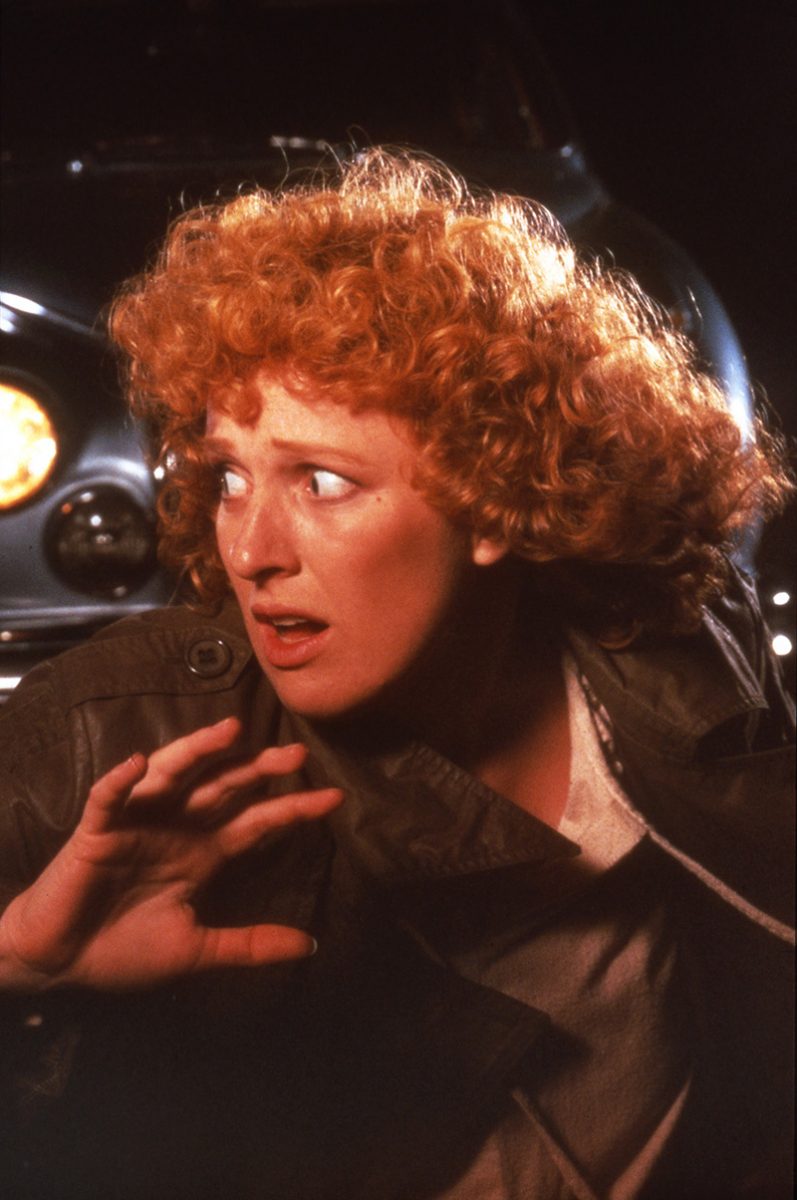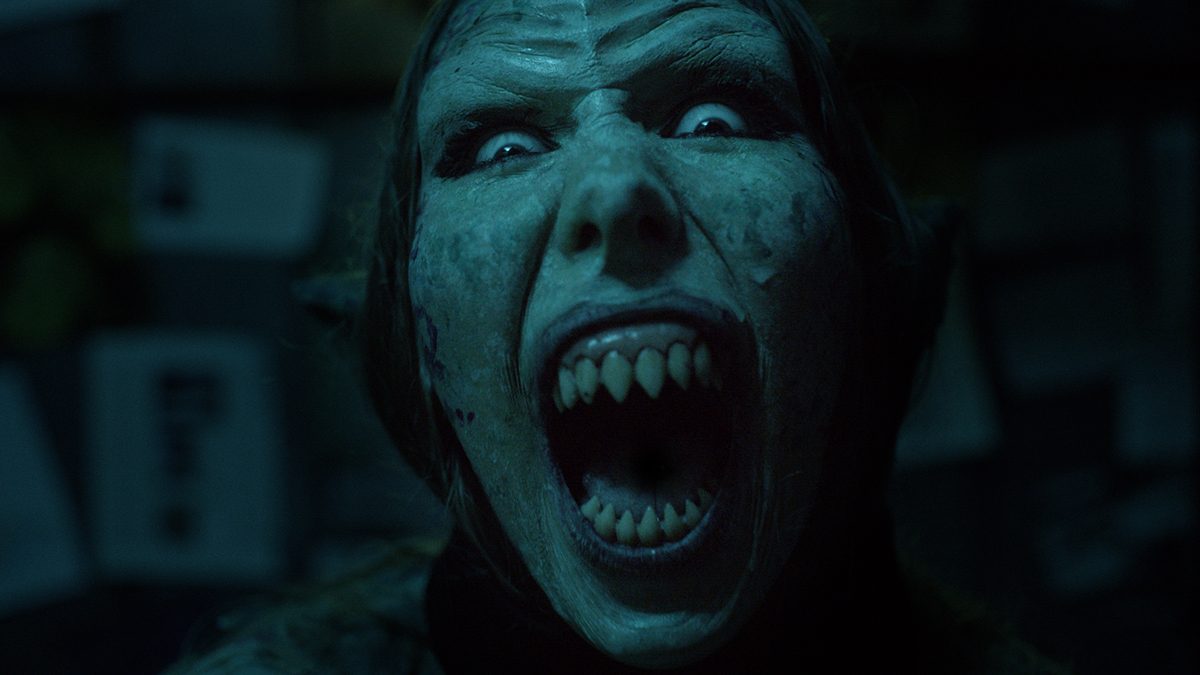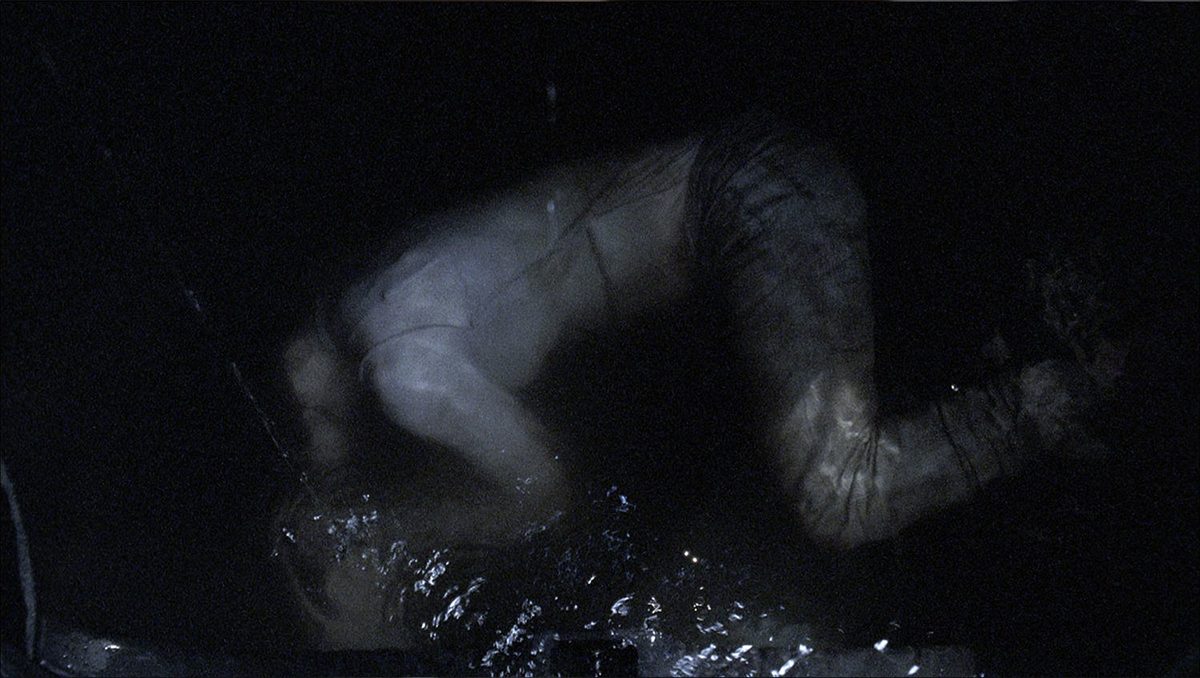Stories about actresses have been a favoured mode of self-examination for the film industry since the earliest days. Going beyond meta commentaries on the artistic life, the archetype began to stand in for ‘woman’ herself. Fragile yet strong, mysterious yet overflowing with emotions, beautiful and yet ugly, the actress on screen became everything men wanted to say about women, in one alluring bundle of contradictions.
As searingly revealing as these portrayals were, with stars like Gloria Swanson, Bette Davis and Gena Rowlands offering up some of their greatest performances, male artists framed and directed the work. Men chose when to move in for a close-up, how to light the face, when to cut away. They chose how ‘messy’ to let things get, and where to end the story. If an actress wanted to say something that was not on the page, she could do so in the subtext, with her skill, but always within a framework established for her by others.
The star
The Second Woman responds to that tradition by placing performer Nat Randall in a box on stage, playing a woman who’s waiting for her lover to visit. A single scripted scene is repeated over and over, with a different man playing the lover each time. The all-female production team, led by Randall and her co-director and co-writer Anna Breckon, includes two camera operators who are live-capturing everything so that it appears on a large screen next to the set. The sound is mic’d so Randall and guest can speak at a conversational level. We are given very little information about the character played by Randall but her glamorous 1960s style (messy yet fabulous hair, perfect make-up) tells us she belongs on screen. As she stands waiting, music swelling, we see her in glorious close-up, glowing with charisma and vitality despite her tortured circumstances. She’s a star.
The performance is scheduled to last for 24 hours, from 3 pm Saturday until 3 pm Sunday, but we have no idea if there will be any particular ‘ending’ to it. With a rolling audience of stayers and newcomers, it’s a popular event even in the early hours of the morning. By the time the last hour begins on Sunday afternoon the theatre is packed, with a line out the door of the Arts Centre and onto the footpath. Most won’t get in; there’s no way those inside are going to give up their positions now. There’s a sense of being part of something special.
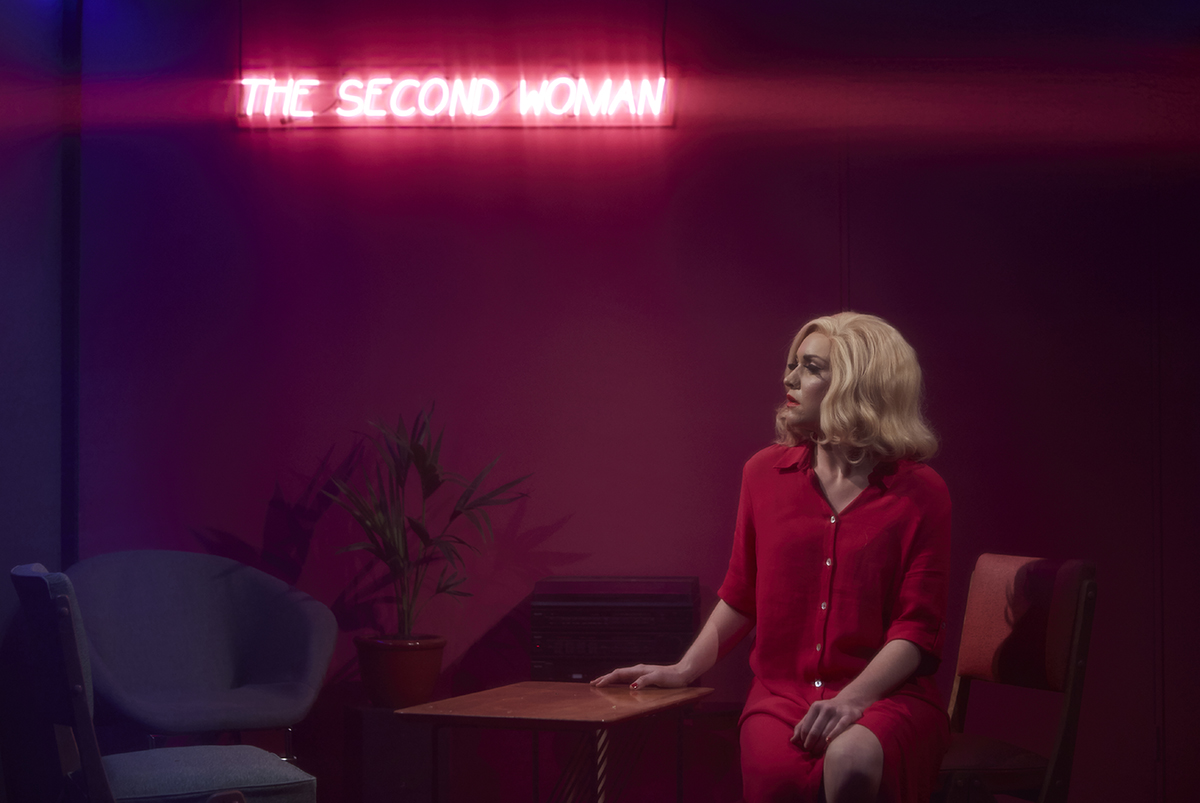
Nat Randall, The Second Woman, photo Zan Wimberley
Repetition compulsion
The scene is inspired by lines and characters from the 1977 John Cassavetes film Opening Night, which starred Gena Rowlands as an actress in crisis. The story in The Second Woman is simple but idiosyncratic. A man named Marty arrives to visit a woman, bringing takeaway Chinese food. They talk and drink J&B whisky, although she’s already drunk. She draws him out on his feelings for her (“What a mess I am, begging again”) and he responds, listing some of her admirable qualities. But what she most wants is not something that occurs to him: that he would think of her as “capable.” Frustrated, she throws food at him and turns on the stereo. They dance for a minute to a disco song (“Taste of Love” by Aura), until she falls down drunk and then tells him to leave, handing him $50 that is perhaps for the meal or perhaps an insult (in reality it’s the man’s fee for performing in The Second Woman). They share a final moment and he leaves her alone. To clean up the noodles. To think. To wait. And then it all begins again… with the same words and actions, more or less, but with a new Marty.
The men
Short, tall, young, old, suave, awkward, cynical, sentimental; Randall encounters men of many varieties. Some are actors, some are obviously not; with others it’s hard to tell. One wears a suit, one a huge colourful sweater, the next a cape. One man has only one hand. One man brings flowers. One tucks the $50 into his hatband as if to say, “I will make lemonade from the lemons of your rejection.” Each has memorised the same script and is operating from the same set of instructions, although able to deviate in certain moments, such as whether he chooses “I never loved you” or “I always loved you” as his last line.
Trust
But Randall owns this space. She’s calling the shots, no matter how much her character’s behaviour might imply otherwise, and the audience’s appraisal of each performance is subtly dictated by hers. But this is not a study of subjugation. Acting doesn’t work like that. For something interesting to happen — something usable, in film terms (although that’s a complicated notion here, where every ‘take’ is shown and has an intrinsic value) — there must be mutual trust. Even the most unlikely of acting partners must be taken seriously, his oddest choices honoured, or it all falls apart. Randall is the star of the show, but it’s also her task to allow each man who enters the room his moment to be seen. In this, and in the careful calibration of her own performance in response to each scenario, she excels, never losing sight of what is being created.
Audience variables
There’s a discipline to this work that can’t be easy to maintain in the face of exhaustion and in front of a festival audience looking for a good time and not always capable of appreciating nuance. Even from the first few iterations of the scene on Saturday afternoon there was laughter where none seemed particularly warranted (maybe some of the audience knew the men on stage, maybe they’d already started drinking) and by the time day turned into night a carnival atmosphere took over, with cheers and laughter flowing freely. By around two in the morning things got a little wild. T-shirts were torn off, dancing got sillier, noodles were flung more exuberantly. The men on stage, and the men in the audience, it has to be said, became increasingly competitive. When a man seemed to win over Randall, and win over the crowd, it became a badge of honour. “That’s our boy, a fine ragout,” I heard a guy in the audience say proudly at one stage. Later, another man waiting for his own performance timeslot muttered to his friend, “This is my moment. I’m scared now though. How do I follow Diamond Shirt Guy?” How indeed.
In-jokes developed: how weirdly will she eat the noodles this time? How could we be surprised by that moment where she totters in her high heels again? The cult of The Second Woman grew at an astonishing rate. By noon on Sunday it would have hardly been surprising to go out into the foyer to find festival-goers wearing “What a mess I am” T-shirts and swigging from ironic bottles of J&B.
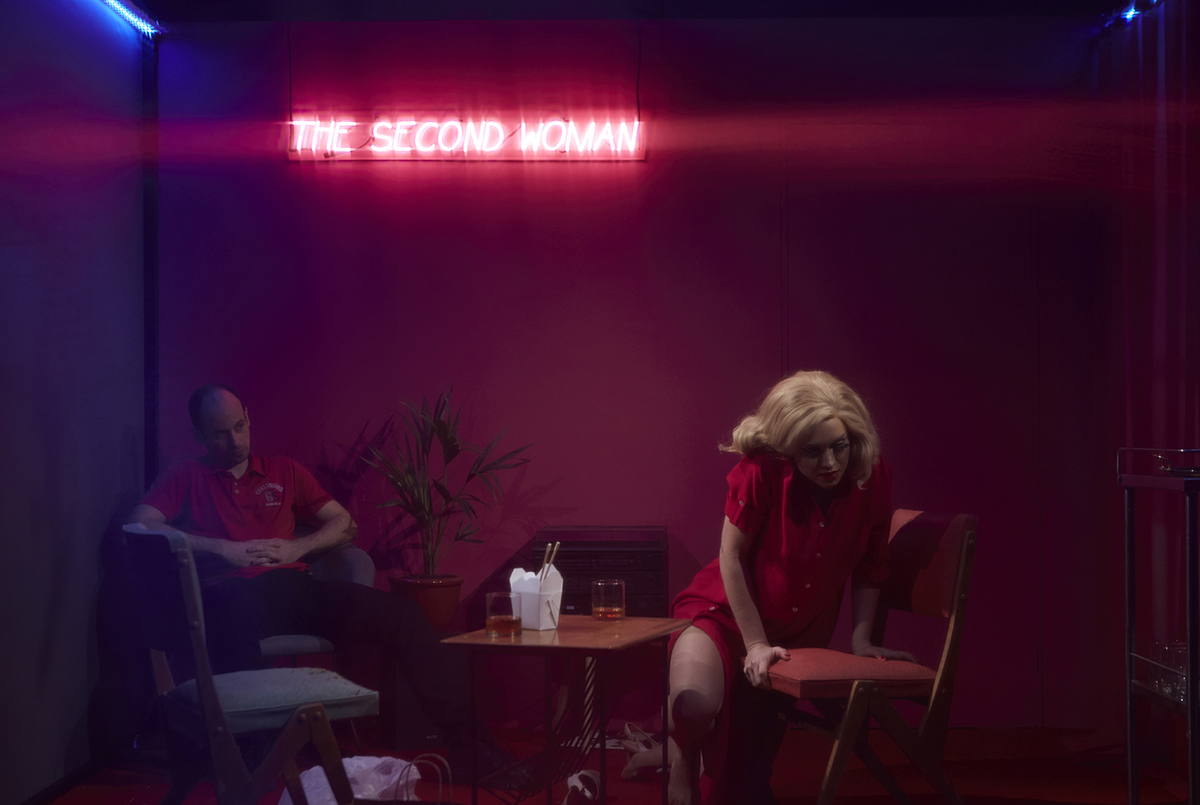
Nat Randall, The Second Woman, photo Zan Wimberley
Men and being
But through all the fun Randall and team, led by Breckon behind the scenes, maintain the integrity of their experiment. Patterns emerge. We see that the same moments — the paying of a compliment, a kiss on the cheek, the slow dancing — are uncomfortable for many of the men. Some of them struggle to express emotion of any kind, and we recognise how vulnerable they are. We begin to understand their attempts less as good or bad acting, but as either honest or dishonest. We’re not looking for gimmicks, we’re looking for something elusive and yet irrefutable. We’ll know it when we see it. Hence the work’s addictive quality, and the danger of binge-watching. (Thought you’d drop in for half an hour? Why not stay for six?).
Women and being
The Second Woman offers a fascinating insight into craft. You’d be hard pressed to find a film about filmmaking, for example, that so cleverly takes you inside the experience of directing (although the show’s live vision-switching can only roughly approximate actual editing). On a deeper level, it’s an exploration of the barriers of behaviour that divide us as human beings, and those too rare, brief moments when we let them go. The work’s feminist perspective allows us to challenge our preconceptions. Could it be that it’s more powerful to ‘beg,’ after all, than to stay silent and ask for nothing?
Happy ending
And, oh yes, the ending. The final Marty is the only female Marty. She brings champagne, and she pours it out too quickly so they have to drink a lot of froth but they enjoy it and the scene is strange and tender and undeniably something. Only some of those watching know that this is Anna Breckon, Randall’s partner as well as collaborator. It doesn’t matter. The audience, by now, is well versed in paying attention to important things that remain unspoken. And as they stand to applaud they’re happy because their actress is happy and can finally rest. And that last bit sounds like a dream but it really happened.
–
Dark Mofo 2017: The Second Woman, concept, performer Nat Randall, script, direction Anna Breckon, Nat Randall, video direction EO Gill, Anna Breckon, lighting design Amber Silk, sound composition Nina Buchanan, camera operation EO Gill, Lewa Pertl, Ella Richmond, Amy Brown, lead vision-switcher Anna Breckon, set design Future Method Studio, hair artist, make-up Sophie Roberts; Peacock Theatre, Salamanca Arts Centre, Hobart, 17-18 June
Top image credit: Nat Randall, The Second Woman, photo Kate Blackmore
In early May I flew to Hobart in anticipation of some of the most interesting dark genre programming around, at an atmospheric film festival that’s hugely supportive of women filmmakers. This was my third experience of Stranger With My Face International Film Festival, now in its fifth year (not counting a hiatus in 2015). Founded in 2012 by Tasmanian filmmakers Rebecca Thomson and Briony Kidd, Stranger With My Face focuses on horror and other genre films directed by women. The one festival of its kind in Australia, it not only provides a rare opportunity to see genre cinema from a range of thought-provoking female perspectives, but also acts as an incubator for women’s feature film projects through its intensive Attic Lab workshop for selected participants.
This year was notable for the presence of renowned New Zealand director Gaylene Preston as both featured filmmaker and mentor for the festival’s developmental Attic Lab. One of the most striking features of the two subversive Preston thrillers included in SWMF’s retrospective program—Mr Wrong (1984) and Perfect Strangers (2003)—was how resonant their commentary on sexism and gender roles remained, despite the passage of time. In a post-screening Q&A, Preston remarked on the films’ implicit feminism, “All the things you see in Mr Wrong came from a point of rage.” While there were strong films at the festival that explored themes other than misogyny, those reviewed here—bar one—contain elements of this rage. All are explorations of the perilousness of feminine archetypes: the ingénue, the ‘slut,’ the dead girl, the siren and the saint.
Mr Wrong
As Preston put it, “There’s a whole interrogation of ‘nice’” in Mr Wrong, a film about a good-natured, unworldly young woman, Meg (Heather Bolton), who buys a powder-blue Jaguar from a used-car salesman so she can drive from the city to visit her parents on weekends. Meg has a pleasant, open countenance and an Annie-like shock of red curls that suggests she hasn’t quite reached the level of urban sophistication of her city housemates. She’s softly spoken, a bit of a worrier. Despite initial reluctance to purchase the large car, she takes the wheel with a sense of optimism, underlined by the film’s jaunty opening theme. This cheerful start is disrupted on her first long drive home out of Wellington, when, drawing up for a rest break at dusk, the car silhouetted against the sea, she has a terrifying, inexplicable experience—something that’s depicted simply yet so creepily it sets us, like Meg, on edge for the rest of the journey.
Mr Wrong is gloriously multifaceted. Looked at one way, it’s a suspenseful, not particularly serious thriller, enjoyably goofy at times (as in a scene where Meg gallivants through a field in her loud jumper after romantically reconnecting with a childhood friend). From another angle, it’s artistic Gothic horror, with its vivid nocturnal cinematography and nightmarish conjuring of rain-swept roads and pale apparitions, the heroine’s face appearing half in shadow behind the wheel. What makes the film singularly compelling, however, is the constant dull murmur of sexual aggression Meg endures; something that threatens to escalate if she fails to be sufficiently ‘nice.’
The ideals of freedom and independence represented by Meg’s car and city job are undercut by the recognition that there’s no escaping harassment, be it from corporeal sexists or an increasingly malevolent vehicle. In this way, and particularly for women, Preston quite viscerally aligns Mr Wrong’s supernatural horror with everyday oppression. It’s telling that some contemporaneous reviewers failed to pick up on her subtext. In her introduction to the screening, academic Deb Verhoeven quoted from the Evening Post, which praised Mr Wrong as, “a fine film endowed with feminine intuition but free of feminist cant.” This, despite the cathartic Gothic finale, a repudiation of violence against women and demonstration of female solidarity powerful enough to reach beyond the grave.
You can watch the trailer here.
Slapper
Everything that can go wrong in Slapper [Australia, 2017], will go wrong in Luci Schroder’s unflinching portrayal of a day in the life of Taylah (Sapphire Blossom), a teenage single mother who’s desperately in need of the morning-after pill—and is broke. The ensuing race against the clock exposes the harsh, inequitable side of hetero sex, compounded by class inequality and petty indifference; no need for supernatural horror in this short drama. Moving through grey, semi-rural suburbia and various chaotic domestic situations, Taylah attempts to hustle the money in increasingly degrading, dangerous ways, trailing her young daughter in her wake.
Schroder has garnered recognition for her music video work, including for the Alpine track “Hands,” which simultaneously deploys and subverts tropes of frank female sexuality. Slapper does away with the music-video gloss but retains the frankness with Blossom’s raw, aggressive physical performance. The fact that Taylah is capable of nastiness doesn’t lessen the empathy with her situation; it just underlines her fundamental lack of agency. Schroder and co-writer Sam West maintain a constant edge of aggression in their economic, skilfully paced narrative, with the excruciating denouement denoting the hopelessness and self-perpetuating misery of systemic oppression.
The Man Who Caught a Mermaid
With this impressively assured graduate short, Kaitlin Tinker [Australia, 2017] presents another sort of suburban nightmare in her ambiguous account of a retired Australian bloke who dreams of catching a mermaid, and succeeds—perhaps. In a seamless transition from gentle whimsy to stark horror, Tinker upends the traditional myth of the siren luring men to their deaths. In so doing, she exposes the darkly constrictive effect of romantic fantasies on women. The film complements Gaylene Preston’s Perfect Strangers, which also critiques the romantic ideal.
What Happened to Her?
Perhaps the bizarrely common filmic trope of the submerged female corpse is a successor to the mermaid. Part-video essay, part-creative documentary, Kristy Guevara-Flanagan’s short film What Happened to Her? [USA, 2016] is a startling assemblage of film and TV clips demonstrating the sheer proliferation of nubile female dead bodies on our screens. There’s no identification of individual titles, but the clips derive from serious, artistic drama (Twin Peaks, True Detective) as well as forgettable forensic crime shows. On her back or face down, in the sand, in the water (of course) or exposed to the gaze of some sad-eyed (usually male) detective in the morgue, “the body” is allowed to speak here through a quiet voiceover, as an actor relays her experience playing the naked corpse (or perhaps it’s several actors, talking about several corpses; it’s hard to tell) while a seemingly inexhaustible collection of examples is displayed. To uncanny effect, she details what it’s like to be told to strip naked and float face-down in water playing dead; to have bruises painted on you by a sleazy make-up artist; to feel vulnerable in front of all-male crews; to embody a real victim on a true crime show. The voice prompts thought about all the women—fictional and real—whose murders have become an entertainment fetish.
The Book of Birdie
Not polemical so much as a transportive mood piece, Elizabeth E Schuch’s first feature, The Book of Birdie [UK, 2017], nonetheless explores an historically powerful female entity—the Christian mystic. It begins with a teenage girl placed in a snowbound nunnery by her grandmother. Played expressively by Ilirida Memedovski, Birdie has the idealised appearance of a fairytale orphan with her heavy dark hair, pale skin and enormous eyes, on which the camera dwells in close-up. Quietly watchful, she’s both childlike and otherworldly.
The hushed atmosphere of the cloister in which Birdie finds herself is enhanced by the snow falling outside. A cocoon, it magnifies the usual intensity of adolescent emotions, giving rise to extravagant visions and fancies. Two other films about adolescent girls in female-dominated institutions are brought to mind: Vardis Marinakis’ numinous Black Field (2009), set in a medieval Greek nunnery, and Dario Argento’s Suspiria (1977), with its dreamlike bizarreness and vivid use of colour.
A strikingly visual director, Schuch cleaves to various hallmarks of Gothic Romance: the cavernous stone nunnery with its elaborate spiral staircase, Catholic paraphernalia, wraiths, blood, snow, the heroine’s appearance, her innocence and mysticism. But she pushes into unexpected territory by making Birdie a source of great energy rather than a wan victim. Joy imbues her brilliantly coloured visions/hallucinations; she jokes with ghosts, falls in love with the groundsman’s daughter and moves through the convent beatifically. Seizing all the imagery at hand in this austere environment, she devises idiosyncratic rituals incorporating Catholic iconography, superhero comics, menstrual blood and—most disturbingly—a miscarried foetus. Through her rituals, Birdie can gain power over female bodily pain and possible past trauma by creatively transforming them into something transcendent.
Sadly, though, Catholicism places inevitable limitations on its mystics; Birdie must eventually confront the impossibility of merging spiritual and corporeal worlds—though not before offering a glimpse of an alternative approach.
It was invigorating, as always, to see distinctive filmmakers at Stranger With My Face shining such personal light on female experience, challenging the dominant narrative through captivating, angry, inspired, artistic works from past and present.
–
Stranger With My Face International Film Festival 2017, Director Briony Kidd, Salamanca Arts Centre, Hobart, 4-7 May
Top image credit: What happened to her?


